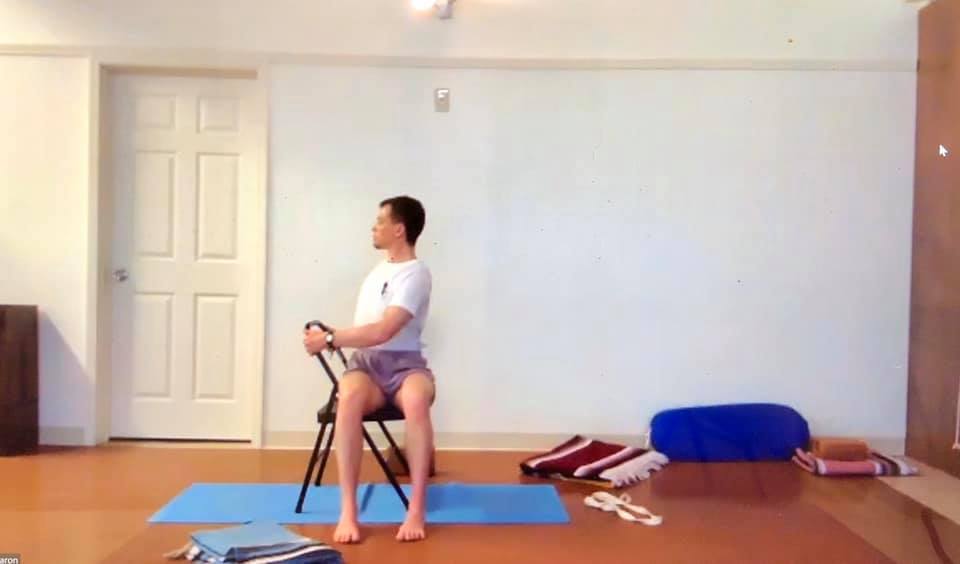Overcoming Our Conditioning

Photo Credit to Susanne Bulington. Photo of my long-time practice buddy, Aaron Fleming, demonstrating Bharadvajasana on a chair.
Day 2 with Abhijata was a great experiment of “relationship” – relationship of us to ourselves, to the poses, and the poses to themselves.
In preparation for the invocation we were asked to “rise up”, physically and mentally, with body and eyes, having the effect of brightness and lightness of spirit. In Adho Mukha Virasana (child’s pose) we were very quickly asked to look at the whole, or the simultaneousness of action. Nothing happens in a void and yoga, as in life, we require great multitasking skills. When we do one thing, what happens, when we do another what else happens. Tying into yesterday, she was trying to tune our perception right away. “If Iyengar Yoga is to have all the answers, we first have to know what needs to be done.” This “knowing what needs to be done” comes from experimentation and “trying things on and giving commentary”.
Exploration and experimentation are words we use a lot in Iyengar Yoga. The aim of yoga is to break so many barriers and preconceived ideas and habits that we carry with us. Can we go beyond what we think we can do? Have we done? What is happening? How do we feel? What prop should be used? Do we really know and can we discern the truth? Yoga helps us to break our “conditioning”, the circle and cycle of craving and aversion that keeps us distracted, attached, and suffering. We have to come to yoga with a clear mind and be willing to get out of our conditioning…even within the context of practice where we can still delude ourselves.
Is a standing forward bend ONLY for after standing poses for “rest”? Is Savasana ONLY done at the end? Shall we NEVER bend a knee in practice? These are the challenges she made to us during this practice. Prashant Iyengar is a master of this challenge as well. In one of his books, Alpha and Omega of Trikonasana, Prashant shows us that Trikonasana (triangle pose) has MANY contexts and approaches. Only through experimentation and knowledge gained through ALL of these approaches and contexts do we manage a full relationship to any pose.
To be “students of asana”, we have to hone the skill of seeing asana from every view. Not only do we need to read the experience from the inside, watch even the biochemistry of the pose – mental, emotional, energetic reactions to any action. But also we must start to read ourselves from the outside as well, to have the “out of body experience” as well. This way we can begin to see all sides, all aspects, and all views of any pose or experience.
Reading ALL of this within an asana gives us access to our Self fully and completely, not just within the narrow view of our own conditioning. Having “access” to something is not just knowing where it is or what it does. Having access to anyone or anything completely is developing a relationship of communication. We have to be willing to accept the reality as it is, to utilize our intelligence to know what is helpful or not helpful, and to see things from all sides and views to have total access in asana.
Abhi ended this class with a great story about sensitivity and her wondering if it could be learned or taught. I LOVED that this story was about a seated forward bend which are my most challenging of poses physically, emotionally, and mentally. In practice with Guruji (BKS Iyengar) one day she was disturbed by her daughter making too much noise and was yelling for her to be quiet. Guruji asked if that was the way she treated her body parts that weren’t contributing to the supposed quiet experience of her Janu Sirsasana (bent leg seated forward bend). He continued…(and this is definitely paraphrased)
Force contributes nothing. It kills curiosity and vanquishes love. Curiosity is the precursor for sensitivity. If we can use props and find ways to explore asana in that manner, without using force, freedom will come in on its own. Freedom is love and freedom makes your mind and intelligence fluid…that is sensitivity. Sensitivity cannot be taught nor can it be learned. It is not an attribute to buy or borrow. It is an expression of freedom, it just flows.
As she settled in to her Janu Sirsasana without force and even with her daughter making noise around, there was no disturbance. Accepting the body parts in what they presented, not forcing something different upon the situation inside or out, she was given access to the flow and the freedom of sensitivity.